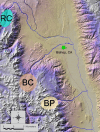A chromosome-scale genome assembly and evaluation of mtDNA variation in the willow leaf beetle Chrysomela aeneicollis
- PMID: 37178174
- PMCID: PMC10320752
- DOI: 10.1093/g3journal/jkad106
A chromosome-scale genome assembly and evaluation of mtDNA variation in the willow leaf beetle Chrysomela aeneicollis
Abstract
The leaf beetle Chrysomela aeneicollis has a broad geographic range across Western North America but is restricted to cool habitats at high elevations along the west coast. Central California populations occur only at high altitudes (2,700-3,500 m) where they are limited by reduced oxygen supply and recent drought conditions that are associated with climate change. Here, we report a chromosome-scale genome assembly alongside a complete mitochondrial genome and characterize differences among mitochondrial genomes along a latitudinal gradient over which beetles show substantial population structure and adaptation to fluctuating temperatures. Our scaffolded genome assembly consists of 21 linkage groups; one of which we identified as the X chromosome based on female/male whole genome sequencing coverage and orthology with Tribolium castaneum. We identified repetitive sequences in the genome and found them to be broadly distributed across all linkage groups. Using a reference transcriptome, we annotated a total of 12,586 protein-coding genes. We also describe differences in putative secondary structures of mitochondrial RNA molecules, which may generate functional differences important in adaptation to harsh abiotic conditions. We document substitutions at mitochondrial tRNA molecules and substitutions and insertions in the 16S rRNA region that could affect intermolecular interactions with products from the nuclear genome. This first chromosome-level reference genome will enable genomic research in this important model organism for understanding the biological impacts of climate change on montane insects.
Keywords: Hi-C; genome assembly; mitochondria.
© The Author(s) 2023. Published by Oxford University Press on behalf of The Genetics Society of America.
Conflict of interest statement
Conflicts of interest statement The author(s) declare no conflict of interest.
Figures




References
-
- Brown WJ. The new world species of Chrysomela l. (Coleoptera: Chrysomelidae). Mem Entomol Soc Canada. 1956;88(S3):5–54. doi:10.4039/entm8803fv. - DOI
-
- Cameron SL. How to sequence and annotate insect mitochondrial genomes for systematic and comparative genomics research. Syst Entomol. 2014;39(3):400–411. doi:10.1111/syen.12071. - DOI
